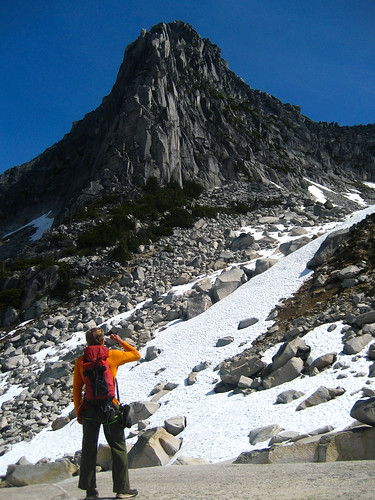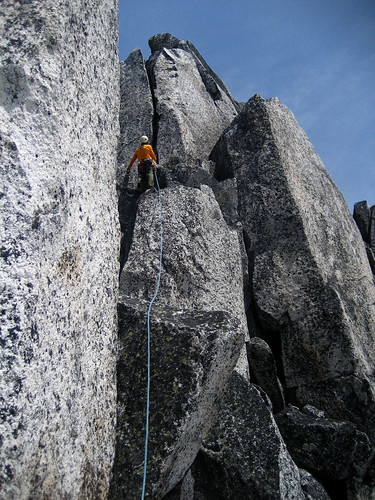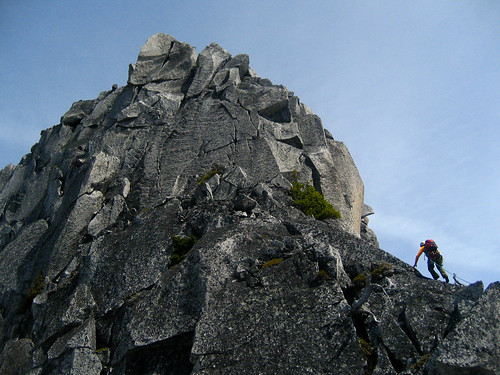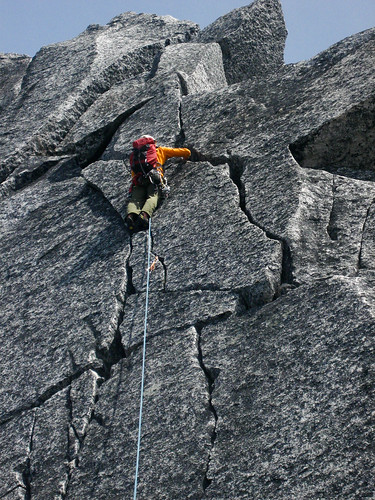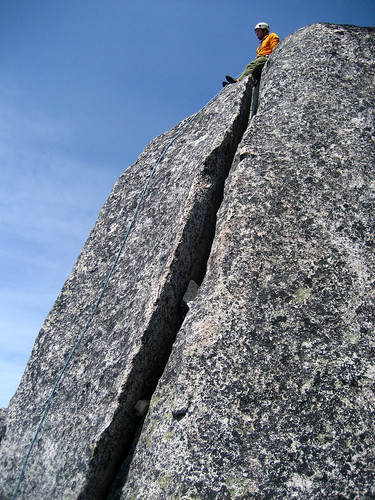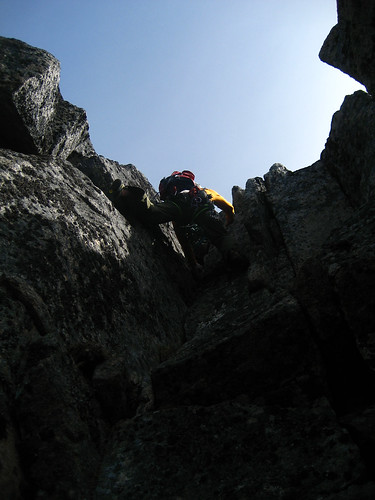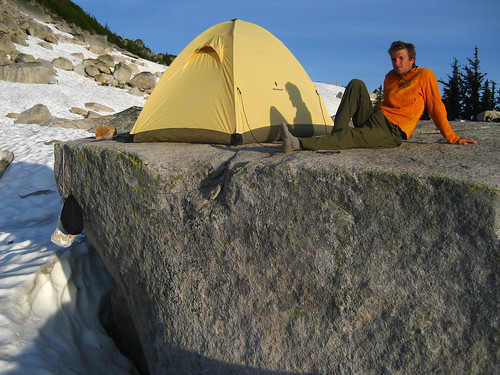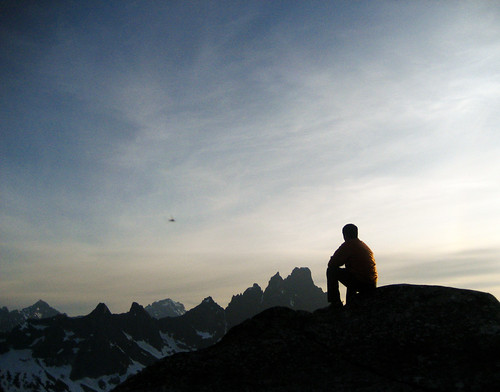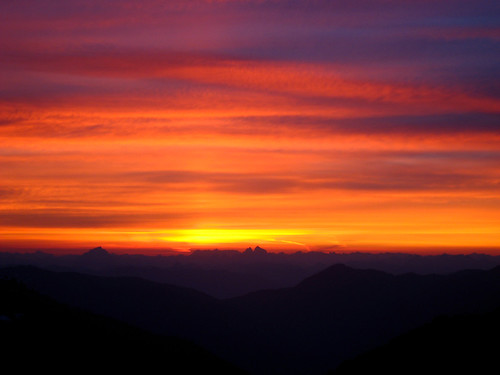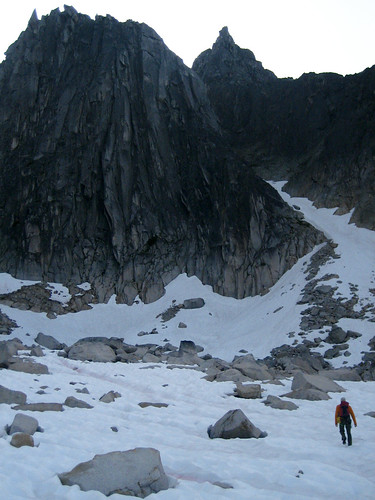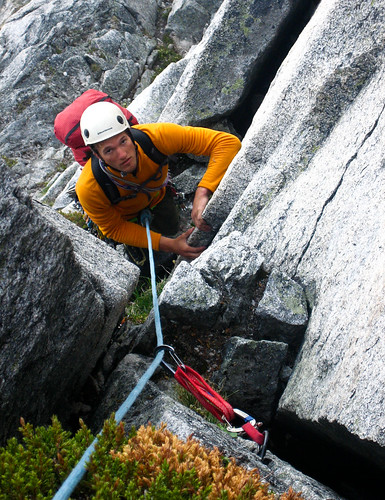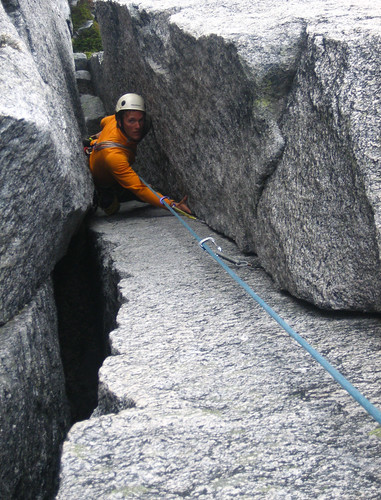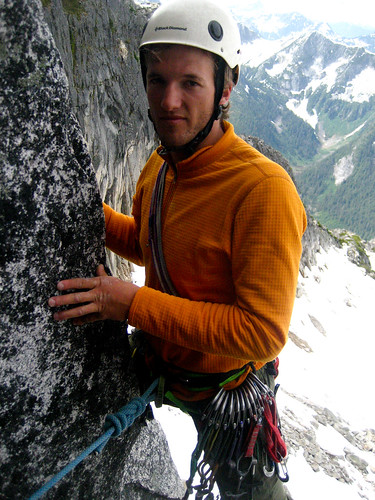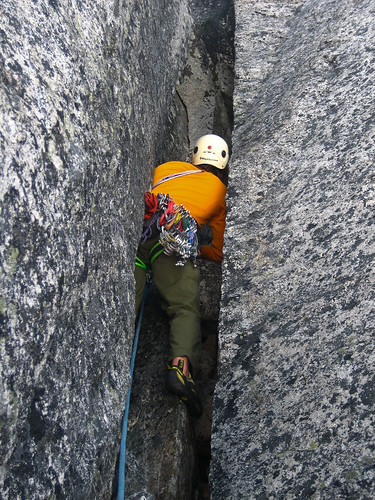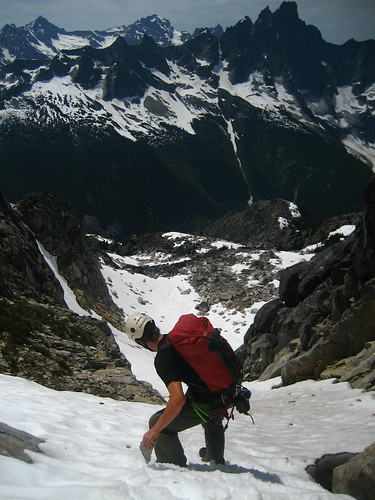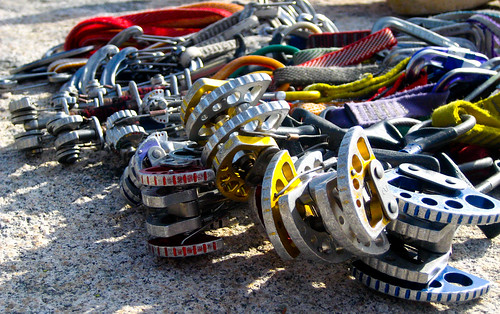Climbing the Nesakwatch Spires
Some of the best alpine rock climbing in southwest British Columbia can be found at the Nesakwatch Spires. It’s been described as a mini-Bugaboo by some friends, but it doesn’t seem like many people climb here. Nick Elson and I were the only ones here this weekend.
A steep approach through a steep cutblock and then granite slabs, leads to an amazing bivy rock, with unobstructed views of Mount Slesse. The enchainment of the North and South Nesakwatch Spires, and Mount Rexford makes for a great alpine outing over solid rock, while steeper routes can be found on the west face of the South Nesakwatch spire. Over the two days, Nick and I climbed the Ensakwatch Enchainment north to south via the southwest ridge of the north spire, and the route Fantasies and Fairytales on the west face of the south spire.
Saturday July 4 2009
The Nesakwatch FSR is in pretty good condition right now, but there were still a few Subaru-scraping waterbars. A higher clearance vehicle would have no trouble driving to the end. Loaded with overnight packs, it was a huge slog up the steep Rexford trail. At least for me anyways, Nick was in much better shape and was barely breaking a sweat. We left the car shortly after 8am, and arrived at the bivy rock around 10:30am. With a day pack, you could probably make it up there in under 2 hours.
The bivy rock is really quite awesome, a massive flat-topped boulder with space to fit several tents. There’s even an optional boulder-problem with a V0- mantle. Perfect way to warm-up for the climbs ahead.
The original plan was to climb Dairyland, supposedly the best route on the west face of the South Nesakwatch spire on Saturday, and then climb Fantasies and Fairytales on Sunday after having scoped out the descent and the rock quality. But the enchainment of the North and South Spire, and Mount Rexford was just too tempting.
The usual Ensakwatch enchainment goes up to the north ridge of the North Spire, down the south ridge, up the north ridge of the South Spire, a rappel down the South spire, up the northwest face of Rexford, and then back down the west ridge.
Nick looking up at the Southwest Ridge of the North Nesakwatch Spire
We opted to climb the Southwest ridge of the North Spire instead of the north ridge, since it looked steeper and better. This was a really good moderate route with some great rock and good cracks. We did it in about 5 long pitches over good 5.9 cracks, and some simul-scrambling. We tried to climb features which would allow us to stay on the ridge crest, but there were many options on either side. The descent down the south ridge was straightforward, avoiding some loose-ish blocks on the ridge. But I should have changed into my approach shoes, as I ended up blowing out the rubber on my right sole.
Richard leading Pitch 2. Photo by Nick Elson.
Below an ominous offwidth. Nick climbed a nicer splitter to the left.
Nick on easy terrain high on the ridge.
Nick climbing the final headwall
We scrambled up the first half of the north ridge of the South Spire, and then simul-climbed up to the base of the heinous offwidth block. The climbing up to here was really good on some perfect handcracks followed by some easy chimney moves. I ended up getting a lot of chimney practice this past weekend, which was much needed.
The summit block is a solid 5.7 offwidth squeeze chimney. There’s no protection at all, unless you drag up a big bro. There is a loose chockstone near the bottom which you could sling, but Nick almost pulled it out when he grabbed it. Nick ended up slinging a cordelette around the flake at the top, and lowered off so I could toprope it. Apparently the trick to retrieving the cordelette is to flick it off with the rope. Easier said than done.
Nick at the top of the offwidth
A few cairns mark the way down from the summit block to the rappel block. One steep 30m rappel took us to the base of the col separating the South Spire and Mount Rexford. The northwest face of Rexford didn’t look good at all from the base and I was remembering how Seth found steep horrible rock on it. For some reason Nick started climbing up towards a rap tap that we saw higher up on the face, and I followed him.
A little bit of low 5th
We ended up scrambling 4th class terrain the whole way up to the false summit. If you roped-up, you would have to be very careful with the way the rope runs due to all the belay-slayer material up there. A little more low-fifth climbing took us to the true summit.
Downclimbing from Rexford
We rappelled off another block off the false summit. This would prove to be a mistake since the rope got stuck in a little groove just below the anchor. We wasted some time here as Nick scrambled up to free the rope, and climbed back down. We should have just downclimbed it, instead of having a false sense of security from seeing rap tat.
Walking down the west ridge was quite pleasant, some nice ridge rambling on heather and granite boulders. A few cairns marked the way down into snow gully, which would have been quite casual with boots and an axe, except we only had approach shoes and rocks.
We were back at the bivy rock around 4:30pm, just in time to nap in the sun and swat at countless mosquitoes. Actually they weren’t that bad, just annoying. What a great day in the mountains! I would definitely recommend doing the enchainment and will likely go back in the future to climb it again.
Critters can’t boulder right?
Evening light
Nick suggested climbing another route, but I declined since I wanted to save what little rubber (and energy) I had left on my right shoe for the route tomorrow. After that long day, Nick and I ate and drank as much as we could, getting water from a stream running underneath a nearby boulder. I watched in awe as the sun slowly set over the Chilliwack valley.
Saturday July 5 2009
We woke up to a bluebird morning with some high clouds. It would be a while before the sun hit the west face of the South Nesakwatch spire, so we took our time getting ready. I don’t think we even left the bivy until 8am. Nothing compared to the alpine start needed if you wanted to be the first party on Diedre on a sunny Sunday. No lineups here. The west face was only a few minutes away from the bivy rock, it almost felt like we were just approaching a route on the Apron, with the addition of snow and boulders.
Nick approaching the West Face
I copied down the description that Craig McGee wrote in the new routes book at MEC, and I’ll just add a few comments here and there on what we climbed. I thought some of the pitches were so good that it would be worth describing in detail. It was some of the most sustained climbing that I’ve done in the alpine or at Squamish. A route to remember, with several memorable pitches. Nick described it as being “sensational,” and I’m sure you’ll agree with him once you climb this route.
“P1. 5.8 50m. Start at the base of a giant corner/flake system of the right side of the face. Climb up to the base of corner (many ways). Large corner has vegetation in it.”
The start of the route was fairly obvious to find. Walk up the snowfield (or talus later in the season) towards the face, just to the right of a massive chimney system. I took the first pitch, since it might have been the only pitch I would lead on the route. The pitch ends at the base of a perfect square chimney. Nothing too hard, but a good warmup for the burl-fest in the pitches to come.
Nick doing a bit of 5.8 grovelling
“P2. 5.10+ 30m. Start up hidden chimney to the left (finger crack in the back). It slowly widens from finger to hands on the left, belay where its possible to step back right at top”
I decided to take this pitch, since the chimney looked amazing, and I thought I might make it to the anchor. The chimney is as good as it looks, with perfect fingers and thin hands in the crack on the left. I climbed the chimney for about 20m until it ended, and was faced with a steep thin-hands to hands crack on the left, or a blocky crack ending in tips on the right. At this point I realized I hadn’t done the hard climbing of the pitch, and I didn’t have the right size cams (0.75 camalot) to protect the 5.10+ jamming since I sewed up the perfect chimney below. I ended up belaying Nick up to bail me out.
The start of Pitch 2. Photo by Nick Elson
Nick seconding the chimney start of Pitch 2.
“P3. 5.11- 30m. Step over and stem/layback up a left facing corner. (fixed nut at crux, start). When corner becomes vegetated (20m), step left and up to sitting belay on flake. “
Nick ended up linking the remainder of Pitch 2, and Pitch 3 as described above. The thin-hand crack was burly, requiring some solid jamming and liebacking. After the crack, the route goes up into another chimney before stepping out into the thin and delicate crux corner. Nick said I should have led it, right up my alley. I’m not so sure about that, it was pretty tricky. You either stem or lieback up a corner tips crack, with only an RP and a crappy fixed #3 nut below. I watched as the RP pulled out with rope drag from higher up. But Nick had better gear by that point.
The steep thin-hand crack of Pitch 2
Nick about to pull into the crux moves of Pitch 3
“P4. 5.11+/5.12- 50m. Step out right and climb the long awesome finger crack splitting the headwall. 5 fixed pins, no hard crux, but sustained. Awesome! (could pull on pin and make it easier 5.11a?)
Variation: on the FA, we climbed up left from the belay to the next corner system to a short chimney to join P5, 2 pitches 1st 50m 5.10 wide (4”) 2nd 20m 5.10 chimney”
We were fully committed to climbing the crux pitch, as we didn’t carry up the #4 camalot for the easier variation. I looked up at the intimidating tip crack splitting the headwall above, just as Nick said it might be a bit too much for us. Nick cruised the first half of the route on a gradually steepening finger crack, but once he moved past a bulge into the tips crack, the battle really began. A full 50 metre pitch of 5.12- sustained and desperate tips crack. (purple tcu and blue alien) Every so often I would hear Nick swearing as he reached one of the pitons, only to discover that the freeze-thaw had taken its toll on it. It would move with just the weight of the rope, let alone a lead fall. Bring a hammer up. And I think it would mid-11 climbing even pulling on the pitons since there was hard climbing above them. Somehow, with a tight belay and desperate smearing, I reached the belay. Pretty inspiring to think of the first ascent of this pitch.
Nick getting ready for battle, I had to straighten his helmet
Richard trying to climb the crux pitch. Photo by Nick Elson.
“P5 20m 5.10+. Traverse an amazing 2 inch foot rail out left, and step over into an unprotected chimney and then back up and right. Belay at the base of large chimney on a ledge. Pitch ends 10m above last belay, but there is 20m of climbing. Belay here to reduce rope drag. “
We were both a bit beat from the previous pitch. From what I could see, the next pitch looked really good with an amazing foot rail traverse out from the belay, so I decided to lead it. I inched my way across the foot rail, only to discover an unprotected chimney separating me from the belay way above. I only had a crappy alien and an RP in a flake near the belay. Nick figured that if I fell, I would probably rip both of them out. Nick was nice enough to tell me that afterwards. Lacking any chimneying technique, I stepped into the chimney, faced the wrong way, and worked my way towards some gear placements a few metres up. Imagine getting onto the chimney at the top of Angel’s crest, only wider, more exposure below, and no gear. I groveled my way to the belay, entertaining and probably scaring Nick with a constant stream of swearing.
I was pretty nervous. Photo by Nick Elson.
Nick following the chimney.
“P6. 40m 5.10+. Climb flake in back of chimney (very cool) then where angle eases back go out right to two pin belay. “
“P7. 20m 5.10. Can combine last pitch for a 60m rope stretch to top. Climb the left facing corner straight above belay. There are three other cracks but this is the cleanest. “
Nick ended up linking the next two pitches to the top. Nick’s really good at doing that. He’ll just find the energy from somewhere and just start pulling hard to the top. The climbing was unrelenting all the way to the top, following a series of corners. One in particular was choked in dirt, and I remember looking up and having a constant stream of dirt entering my eyes. I found some black specks of lichen in my eyes when I got home. Even the last corner to the top wasn’t a give-away, forcing some steep corner work.
The chimney and flake of Pitch 6
We were pretty happy to be at the top of the route. There was still the offwidth summit block, but of course we didn’t bother doing that again. Seth would probably call this a “pretty good failure” since we didn’t summit. We descended the snow gully between the South spire and Rexford.
Approach shoes and rock axes
Back at the bivy rock, we celebrated with a fresh mango. We weren’t quite the mountain hardmen, but we still had a lot of fun on the route. We thought about staying another night (original plan), and climbing another route the next day, but it was probably going to rain so we packed up and slogged down the trail. Nick asked me which was my favourite fast food joint, but I didn’t care so we ended up at Dairyqueen.
Ensakwatch Enchainment via the Southwest ridge of Nesakwatch Spire
Rack: A typical Squamish rack should be enough
Fantasies and Fairytales 5.12-, FA by Craig McGee and Lori O’Hare.
Rack: 3x TCUs #0-4, 2x cams to 2”, 1x 3”, 1×4” for variation, small nuts and RPs
– we didn’t have the 00’s but they would have been useful on the crux pitch, maybe bring one or two
– two of the five pitons on the crux pitch were falling out, so a hammer would be useful
A beefy rack for the alpine

